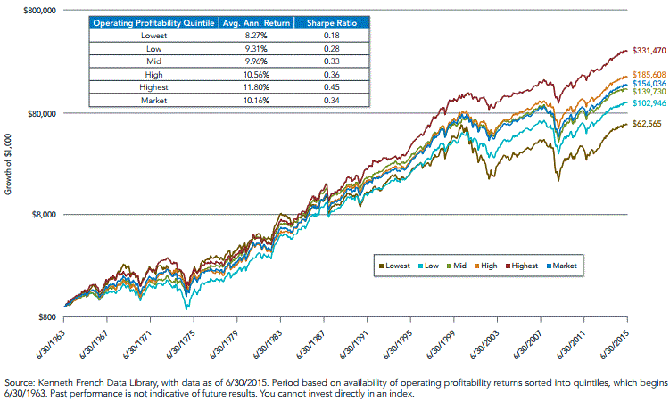One of our most popular blog posts this year has been the one that connects our
quality dividend growth Index methodology to
the way Warren Buffett looks at potential acquisitions, key aspects being:
Berkshire Hathaway Inc. Acquisition Criteria1
• Demonstrated consistent earnings power
• Businesses earning good
return on equity (ROE) while employing little or no debt
The key phrase is “businesses earning good returns on equity while employing little or no debt.” However, the Quality Discussion within equity investing has a long history, and Warren Buffett certainly isn’t the only one to mention it.
Benjamin Graham’s Quality Criteria
One of Warren Buffett’s teachers, Benjamin Graham, who is known as one of the fathers of
value investing, also had a rigorous focus on quality traits. Many focus on Graham’s criteria for finding inexpensive companies, but he was at least equally focused on attributes of quality, if not more so.
Benjamin Graham’s Attributes of Quality2
• “Adequate” enterprise size, as insulation against the “vicissitudes” of the economy
• Strong financial condition, measured by
current ratios that exceed 2 and
net current assets that exceed
long-term debt
• Earnings stability, measured by 10 consecutive years of positive earnings
• A dividend record of uninterrupted payments for at least 20 years
•
Earnings-per-share growth of at least one-third over the last 10 years
Fama-French Operating Profitability Factor
Research done by Kenneth French and Eugene Fama arrives at a similar place. In their draft of “A Five-Factor Asset Pricing Model” from September 2014, they cite operating profitability, defined as annual revenues minus cost of goods sold, interest expense and
selling, general & administrative (SG&A) expenses, all divided by
book value of equity. Note, this is similar to Buffett’s criteria above: a company earning a good return (profits) on its equity (book value)—in other words, a high ROE.
Arranging the U.S. market into
quintiles based on operating profitability further emphasizes that high-quality stocks have won over longer holding periods.
The Spectrum of Operating Profitability Quintiles from June 30, 1963, to June 30, 2015

•
Top Two Quintiles Outperformed the Market: We saw the top two quintiles outperform the market on two fronts—average annual returns and
Sharpe ratio. In other words, this outperformance was not achieved with a significant increase in risk.
Grantham on Why Quality May Outperform over Long Periods
One of the long-standing investment practitioners of quality investing has been Jeremy Grantham’s firm, GMO. In a paper written in 2004,
3 GMO wrote of quality firms:
… even though many of these corporations tend to generate high profits year after year, they are systematically underpriced because they lack
volatility. Instead of overpaying for these companies, as finance theory would suggest—given their low
risk profile—shareholders in fact do just the opposite: they underpay. The result is that investors in high-quality companies get to forge ahead with 15+% returns year after year without overpaying. Of course, in any given year, low-quality stocks can and do stage rallies and high-quality stocks can underperform. But the high-quality stocks have always won over longer holding periods. No matter what metric is used to identify quality stocks—
leverage, profitability, earnings volatility or
beta—high-quality stocks have beaten out low-quality stocks.
In other words, the desire to try to find that “next big thing” tends to exert so much power over the investment psyche that focusing on quality companies has, at least historically, been one avenue through which to achieve outperformance.
We will continue exploring some of our other findings from our research into the concept of quality investing.
Click here for the full in-depth research piece “The Dividends of a Quality and Growth Factor Approach.”
1Source: Berkshire Hathaway annual letter to shareholders from Warren E. Buffett, 2/28/15.
2Source: Benjamin Graham, “The Intelligent Investor” (4th revised edition), Harper & Row, 1973.
3“The Case for Quality—The Danger of Junk,” GMO white paper, 3/04.
Important Risks Related to this Article
Dividends are not guaranteed, and a company’s future ability to pay dividends may be limited. A company currently paying dividends may cease paying dividends at any time.


 • Top Two Quintiles Outperformed the Market: We saw the top two quintiles outperform the market on two fronts—average annual returns and Sharpe ratio. In other words, this outperformance was not achieved with a significant increase in risk.
Grantham on Why Quality May Outperform over Long Periods
One of the long-standing investment practitioners of quality investing has been Jeremy Grantham’s firm, GMO. In a paper written in 2004,3 GMO wrote of quality firms:
• Top Two Quintiles Outperformed the Market: We saw the top two quintiles outperform the market on two fronts—average annual returns and Sharpe ratio. In other words, this outperformance was not achieved with a significant increase in risk.
Grantham on Why Quality May Outperform over Long Periods
One of the long-standing investment practitioners of quality investing has been Jeremy Grantham’s firm, GMO. In a paper written in 2004,3 GMO wrote of quality firms:


